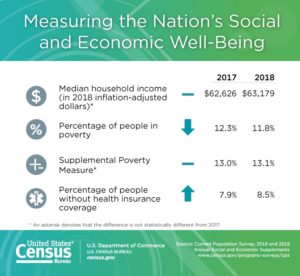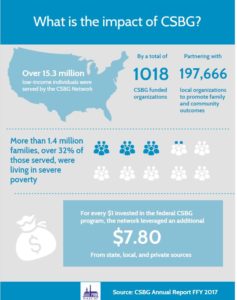Yesterday morning the U.S. Census Bureau released its latest data on poverty, income, and health insurance coverage. The results showed that between 2017 and 2018, incomes stayed flat, the official poverty rate declined slightly, and more people became uninsured.
Highlights of the Census Report
- Income: Real median household income in 2018 was $63,179. This was not statistically different from the median in 2017.
- While the median income did not change this year, incomes had increased in each of the previous three consecutive years.
- Poverty: In 2018 the official poverty rate was 11.8%, a decrease of 0.5 percentage points from 2017 (12.3%). This is the fourth consecutive annual decline in the national poverty rate.
- The number of people in poverty in 2018 was 38.1 million, 1.4 million fewer people than 2017.
- In 2018, for the first time in 11 years, the official poverty rate was significantly lower than 2007, the year before the most recent recession.
- Health Insurance: The rate and number of people without health insurance increased from 7.9%, or 25.6 million, in 2017 to 8.5%, or 27.5 million, in 2018.
- Supplemental Poverty Measure: The Supplemental Poverty Measure (SPM) takes into account various programs, tax credits, and expenses in a more nuanced view of the poverty rate.
- In 2018, the overall SPM rate was 13.1 percent. This is not statistically different from the 2017 SPM rate of 13.0.
- The SPM rate for 2018 (13.1%) was 1.3 percentage points higher than the official poverty rate of 11.8 percent.
- Social Security was considered the most important program, moving 27.3 million individuals out of poverty. Refundable tax credits moved 7.9 million people out of poverty.
Impact of the CSBG Network on Poverty
The CSBG network tackles the complex issues of poverty by addressing the needs of individuals, families and communities within domains such as employment, education, health, housing, and more. Using programs and services tailored to local needs, the CSBG Network is working daily to help families achieve economic security. A few outcomes from Federal Fiscal year (FFY) 2017 include:
- 6.5 million participants with low-incomes obtained supports which reduced or eliminated barriers to employment, or acquired a job, obtained an increase in employment income, or achieved “living wage” employment and benefits.
- 4.4 million infants, children, youth, parents and other adults participated in developmental or enrichment programs facilitated by the CSBG Network and achieved program goals.
- 3.1 million vulnerable individuals with low-incomes received services and secured or maintained an independent living situation as a result.
- 2.9 million community resources or opportunities (e.g. transportation programs, youth programs, health care services, affordable housing, and child care programs) were improved or expanded for people with low-incomes as a result of CSBG Network projects or initiatives.
- 1.1 million community members and people with low incomes mobilized to engage in activities that support and promote their own well-being and that of their community as a direct result of CSBG Network initiatives.
More Work to Be Done
The new Census data shows that while significant gains in the fight against poverty have been made, and that antipoverty programs are indeed reducing poverty rates, there are still 38.1 million people living in poverty who need continued support. However, programs like CSBG that are proven to move people out of poverty continue to face threats of funding cuts and full-scale elimination. In FY17 alone, the CSBG network served 15.3 million low-income individuals and over 6.3 million families. Of the 6.3 million families served by Community Action, over 32.7% were in severe poverty, living below 50% of the Federal Poverty Guidelines.
In addition to these annual poverty numbers, the data collected as part of the upcoming 2020 Census will also be critical to painting a picture of poverty in the U.S. The 2020 Census will play a key role in the development of anti-poverty programs and their funding levels. States and localities around the country are forming Complete Count Committees (CCCs) to increase awareness of and to support residents to respond to the 2020 Census. CCCs are instrumental in planning for and supporting participation for hard-to-count (HTC) populations which include households with low-incomes, renters, rural populations, single-parent headed households, and ethnic or minority populations. The national Community Action Partnership is working with local Community Action Agencies and CSBG State Offices in an effort to reach the HTC populations served by the CSBG network. Learn more about the Community Action Complete Count Committee here.
Headed into 2020 and beyond, the CSBG network is at the forefront of innovation in the fight against poverty. Community Action Agencies are paving the way with innovative models such as bundled services, two-generation approaches, collective impact, and more. As it has for over 55 years, the CSBG network will continue to serve as a leader in the effort to eliminate poverty in America.
For more resources and analysis of the new poverty data, check out the following sources:





